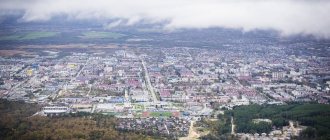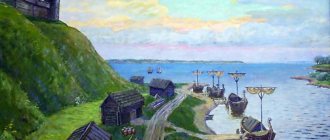| Stavropol |
Stavropol
, a city in Russia, the administrative center of the Stavropol Territory, the cathedral city of the Stavropol diocese and the center of the Stavropol Metropolis.
Located in the central part of the Ciscaucasia, on the Stavropol Upland, in the upper reaches of the Tashla River, 1621 km south of Moscow. Railway station, highway junction. A large industrial, administrative and cultural center of the North Caucasus. Population - 412.1 thousand (2013) historically Stavropol was also called the ancient city on the site of the village of Geyre in Turkey; a short-lived fortress on the Sulak River in the 18th century; the city of Togliatti in Russia before 1964
- On the map: Yandex.Map, Google map
| View of the Stavropol fortress |
Stavropol-Caucasus
arose as a border outpost of the Russian state. The city grew out of a fortress founded in 1777 on the Azov-Mozdok defensive line, created to protect the southern borders and roads to the Don and Volga. The name reflects the widespread practice in Russia at the end of the 18th century of assigning pseudo-Greek names to new settlements: Stavropol - “city of the cross” (from the Greek Σταυρός - cross, πολη - city). The name was proposed by G. A. Potemknin, believed to be in continuity with the Stavropol fortress at the mouth of the Sulak River, founded by Peter I in 1722, but razed in 1738.
The structure of the city fortress had the shape of an elongated polygon, the basis of which was two intersecting axes. In a short time, the settlement acquired the significance of an important economic center of the North Caucasus. Since 1785 - a district city of the Caucasus region of the Caucasian governorship (since 1796 - Astrakhan province), since 1803 - in the Caucasus province. At the end of the 18th-19th centuries, the main postal route connecting the Caucasus with the central regions of European Russia passed through Stavropol.
In 1822, when the Caucasian province was transformed into a region, Stavropol became its center. Since 1833, the city was built up according to a regular plan, taking into account the complexities of the terrain. Since 1847 - the center of the Stavropol province of the Caucasian governorship (in 1898, the Stavropol province was administratively separated from the Caucasus). The city served as the center for command and control of troops throughout the Caucasus line and the Black Sea region.
The city developed intensively until the opening of the Vladikavkaz railway in 1875, laid more than 50 km to the south. At the end of the 19th and beginning of the century, Stavropol was predominantly a merchant city; trade was carried out mainly in grain and livestock. In 1897, the city was connected by a railway line with the Vladikavkaz Railway.
In 1935, renamed Voroshilovsk
named after the Soviet party and statesman K. E. Voroshilov.
In 1937-1943 - the center of the Ordzhonikidze region. During the Great Patriotic War, Stavropol was occupied by Nazi troops on August 5, 1942 and liberated on January 21, 1943 by troops of the Transcaucasian Front during the North Caucasus Operation. In 1943, before the liberation of the city from occupation, the name Stavropol
. Since the 1950s, modern housing construction has taken place.
Statistics
- 1856 - 17.3 thousand people, 16 churches, 2187 houses, 268 shops
- 1897 - 41.6 thousand people
- beginning V. — 27 Orthodox parishes; church, synagogue, church, mosque
- 1913 - 62.4 thousand people
- 1926 - 57.4 thousand people
- 1939 - 85.3 thousand people
- 1956 - 123 thousand people
- 1973 - 219 thousand people
- 1989 - 318.3 thousand people
- 2003 - 354.9 thousand people
Home\Stavropol Territory\Administrative-territorial division\City and municipal districts
City of Stavropol, Stavropol Territory
Official website of the Stavropol city administration : https://stavropol.rf/
General information about the city district:
area of the urban district – 27,669 hectares;
the population of the city of Stavropol as of 01/01/2019 is 437.3 thousand;
postal address of the Stavropol city administration : 355035, Stavropol city, K. Marx Avenue, 96;
phone number of the Stavropol city administration: (8652) 26-03-10.
Head of the city of Stavropol:
Ulyanchenko Ivan Ivanovich;
date of election: June 11, 2022;
term of office: 5 years.
Chairman of the Stavropol City Duma:
Kolyagin Georgy Semenovich;
date of election : September 30, 2016;
term of office: 5 years.
Brief information about the city of Stavropol:
The city of Stavropol is the administrative center of the Stavropol Territory of the Russian Federation, one of the largest business, logistics, educational and cultural centers in the Russian Federation. It is a municipal entity and has the status of an urban district.
Founded in 1777 as the sixth fortress of the Azov-Mozdok defensive line. Located on the hills and valleys in the central part of the Ciscaucasia on the Stavropol Upland in the upper reaches of the Tashla River at the intersection of the Rostov-Stavropol and Astrakhan-Elista-Nevinnomyssk-Cherkessk highways. Extreme altitudes range from 230 to 660 meters above sea level. One of the streets in the city of Stavropol is called 45 Parallel, indicating its exact latitudinal position. Thus, the city of Stavropol is equidistant from the North Pole and from the equator.
Climate: temperate continental, average annual precipitation: 400-650 millimeters per year. Average temperatures in January: from minus 9 degrees Celsius to minus 5 degrees Celsius, in July: from plus 22 degrees Celsius to plus 24 degrees Celsius.
The area of the urban district of the city of Stavropol is 27,669 hectares. The area of built-up land plots is 46.2 percent of the total area of the urban district. The length of the border of the city of Stavropol is 165.3 km. The city of Stavropol also includes the Grushevy farm. On the territory of the city of Stavropol there are horticultural, market gardening and dacha non-profit associations of citizens (10,460 hectares) and the Sengileevskoye Reservoir (4,200 hectares).
The territory of the urban district is divided into three districts:
1. Leninsky district of the city of Stavropol. Founded in 1962, it is located in the southeastern part of the city.
2. Oktyabrsky district of the city of Stavropol. Formed in 1962, it occupies the central and northeastern parts of the city.
3. Industrial district of the city of Stavropol. Founded in 1977, located in the western part of the city.
The city of Stavropol is one of the greenest cities in Russia. A special feature of the city of Stavropol is that the forests are adjacent to urban development. The area of green spaces is over 4 thousand hectares.
The cultural life of the city of Stavropol is represented by a variety of state and municipal institutions of various creative orientations.
On the territory of the city of Stavropol there are two theaters - the Academic Drama Theater named after. M.Yu. Lermontov and a puppet theater, a philharmonic society, six museums of fine arts, a museum-reserve named after. G.N. Prozritelev and G.K. Prava with branches (an art gallery of landscapes by the artist P.M. Grechishkin, the estate of the artist-academician V.I. Smirnov), the museum and exhibition complex “My Country. My History", Museum of the Great Patriotic War of 1945-1945, Parshin Gallery, Zoo Exotarium, four leading regional libraries and seventeen city public libraries, a college of arts and an art school, seven institutions of further education in the field of culture, nine club institutions (Palaces and Houses of Culture, youth cultural and leisure centers), 198 monuments of history, culture, architecture, and urban planning.
The city of Stavropol takes an active part in the development of international intermunicipal cooperation and regularly interacts with sister cities of foreign countries: Pazardzhik (Republic of Bulgaria), Beziers (French Republic), Des Moines (United States of America), Zhenjiang and Changzhou (People's Republic of China), Yerevan (Republic of Armenia).
Stavropol
Video: Stavropol from above
Weather in Stavropol
Stavropol is open to all winds, especially in February-March, so despite the mild climate, the weather in the city can bring surprises. Summer is dry and hot, but in June there are also showers and thunderstorms. In winter it is frosty and clear, but subtropical winds bring thaws.
Snow-covered Tukhachevsky street
View of the 6th and 7th microdistricts of Stavropol
City `s history
Like most southern cities of the country, Stavropol was founded as a fortress. The first fortifications date back to 1777. The choice of location for the construction of defensive structures was not accidental: on one side, the positions were reliably protected by a cliff to the Tashly River, and from the south there were small river beds that hampered the enemy’s advance. In the east, beyond the territory of the fortress, the approaches to it were closed by the Stavropol village, where the Cossacks lived.
At the beginning of the 19th century, the importance of Stavropol-Caucasian increased - by order of General Ermolov, the main military forces of the Ciscaucasia were concentrated in this city, and at the same time the role of the local Cossacks increased. With the change in the borders of the state and their advancement to the south, Stavropol lost its strategic importance, but continued to develop as the center of the province. After the revolution, the composition of the population of Stavropol changed significantly: many local Cossacks were evicted, and residents from Central Russia came to their homes. From 1935 to 1943 the city was officially named Voroshilovsky, while the region remained Stavropol, then the historical name was returned, however, without the second part “Caucasian”.
Library in the 20th century SKUNB named after. Lermontov
Old photos of Stavropol. Tiflis Gate, 1900
Pre-revolutionary Stavropol
Cossacks of Stavropol
The first Cossack settlers, mainly Terek and Kuban, appeared in the Stavropol region in the second half of the 18th century spontaneously, without orders from state authorities. On the territory of the modern city, the Cossack village was located within the Lower Market. The settlement was planned as a Roman camp, with a regular grid of residential buildings, the necessary administrative services and defensive ditches. The latter was a necessary precaution due to regular raids by Caucasians. Since 1825, the borders of the empire changed; the city no longer needed so many Cossacks, so they were massively resettled to the south, forcing them to abandon their homes and farms. After this, it turned out that the province had almost no military personnel of its own, so some of the local peasants - Russians and Ukrainians - were registered as Cossacks.
Stavropol Cossacks
In 1832, the Caucasian Cossack Line Army was organized with headquarters in Stavropol and the Stavropol Cossack Regiment as part of it. The new formation turned out to be effective, playing the role of both the military and the police. In case of alarm, all Cossacks and militias from the villages closest to Stavropol rose within an hour. Since that time, Stavropol and its environs have become much calmer, new farmsteads have appeared outside the fortifications, and agriculture has developed.
The history of the Stavropol Cossacks was interrupted in 1860, when the Stavropol region lost the Terek region, with its center in Vladikavkaz, and the Kuban region, with its center in Yekaterinodar. The very concept of Stavropol Cossacks was lost: only those officially assigned to the Terek and Kuban Cossacks remained in the city and surrounding areas. After the revolution, everything became even more mixed up: the Terek Cossacks were evicted to the Stavropol region, the locals to Siberia. In 1924, the Cossack cavalry units were revived, after the war a higher riding school operated in the city for the needs of the army, but in 1955 the Cossack troops were finally disbanded as morally obsolete.
Museum of Cossack History
In 1990, a congress was held in Stavropol dedicated to the revival of the local Cossacks. Today, the city has a Cossack ataman, a position officially recognized at the federal level. Not far from the station is the Museum of Cossack History with a diorama, historical clothing and weapons of the Cossacks. The Cossack Union participates in all city events and conducts educational work.
Stavropol from above
Natural attractions of Stavropol
The Sengileevskoye Reservoir
Stavropol is famous for its spectacular landscapes: hills covered with grass, shady forests, springs and waterfalls. Formally within the city, but in fact 18 km from its center, the Sengileevskoe reservoir, formed in 1958, is located – the main source of water for Stavropol. Although the local thermal power plant discharges water into it, the lake is considered clean; it is inhabited by shemaya, silver carp, bream, fisherman, and bester - a hybrid of beluga and sterlet. There are no annoying large algae in the water; Thanks to protective structures at the spillway that prevent the outflow of juveniles, the number of fish in Sengileevsky is growing every year. However, tourists will not be able to enjoy this splendor: swimming and fishing in the reservoir are prohibited.
Beach holiday
Stavropol residents are not afraid of the ban on diving into the Sengileevskoye Reservoir: there are many beaches in the city itself and in its environs. Within the boundaries of Stavropol there is Komsomolskoye Lake with a sandy shore and all amenities, but not very clean water. You can plunge into running spring water in Koryty, baths at the Cold Spring and at Mikhailovsky. The Novotroitskoye and Yegorlykskoye reservoirs are open to the public – the latter is favored by kite surfers. Within an hour's drive of the city there are many bases with well-equipped beaches on ponds and lakes, usually with good fishing. The beaches closest to Stavropol have only two drawbacks - a muddy bottom and the need to fork out for a vacation on a clean shore.
Lenin Square in Stavropol
City attractions
Founded two and a half centuries ago, Stavropol is not rich in historical and architectural monuments, but interesting tourist sites can be found there. A monument to interesting geography is 45 Parallel Street, which lies at an equal distance from both the pole and the equator.
The symbol of Stavropol is the “Cross” monument, erected in 1900 on Cathedral Hill in memory of the centenary of the death of Suvorov. The guardian angel of the city was installed already in our century on Alexander Square.
Guardian Angel of Stavropol
The German Bridge across the Mamaika River, built by prisoners of war during the First World War, stands apart. The object resembles the ruins of a Roman aqueduct in the middle of a forest. Once upon a time it was supposed to become a railway, now it is a simulator for climbers.
German bridge over the Mamaika river
Open-air museums and parks of Stavropol
A visit to the archaeological sites in the Tatar settlement and the botanical garden is great entertainment for the whole day. The first is located in a protected area, so it can only be visited with a guide; relaxation in the garden is available to everyone for a modest fee.
Botanical Garden of Stavropol
The largest botanical garden in the southern part of the country contains 17 collections of plants from around the world. Although there are noisy city highways nearby, peace and quiet reign on the alleys, lawns and in the garden's greenhouse. Educational institutions introduce new plants, conduct educational programs for schoolchildren, and create landscape design projects. From March to November, the Stavropol Botanical Garden is open daily from 9 a.m. to 6 p.m.; during the rest of the year it closes an hour earlier. A ticket for schoolchildren costs 50 rubles, for adults – 100 rubles, with a tour – 2 times more expensive.
Botanical Garden of Stavropol
Tatar settlement
In the forests near Stavropol, at its southern borders, traces of Koban, Scythian, Sarmatian and Khazar settlements were discovered: roads, fortifications, temples, burial grounds from the 8th century. BC e. according to the 10th century n. e. In order not to damage the reserve, it is prohibited to hunt, pick mushrooms and berries, or be unorganized in the forest. A three-hour excursion costs from 180 rubles per person. You need to prepare for a trip to the settlement as you would for a small hike: choose comfortable clothes, provide protection from the sun, take water and some food with you, since there is basically no tourist infrastructure nearby. The road will pass through the hills - tourists are required to be in good physical condition.
In fact, it is difficult to guess without an experienced guide that the ramparts and remains of the fortress are hidden under the lush vegetation. The only thing that catches your eye is the crypt burial ground made of large stones, which is about 2.5 thousand years old. The Tatar settlement also hides many natural attractions. The Pagoda waterfall in a beech forest falls along tiers-ledges, on which icicles effectively freeze in winter. The travertine waterfall is made of blocks of limestone tuff.
Tatar settlementVictory Park
Occupying an area of 200 hectares, the park is located in a natural forest in the southwest of Stavropol. Several dozen attractions, a water park, and an ice skating rink have been built here. On the territory of Victory Park, to the right of the central alley, the only ropes course “Panda Park” in the region is open. Its guests are offered 3 routes with a height of 0.5 to 6 meters. “Children’s”, designed for visitors 4-7 years old, runs along logs and cables half a meter from the ground. On the “Bold” you need to overcome 11 obstacles at a height of 3 m in half an hour, including a suspension bridge, ropes and a zipline descent. The most difficult, “High”, offers crossing bridges, riding a bicycle on a cable, and jumping from a platform. The cost of participation is 50 rubles for children, for adults – from 200 rubles.
Victory Park in Stavropol
Museums of Stavropol
The museum life of Stavropol is active and diverse - from traditional local history and art collections to interactive natural science exhibitions. Archaeological collections and contemporary art galleries are of particular value.
Historical-cultural and natural-landscape museum
The skeleton of a southern elephant is on display at the museum.
The institution is named after local historians Prozritelev and Prave. The first began with ethnographic collections, the second - with natural sciences, prepared for the needs of school education. The collection is exhibited in a historical building built in 1873 - a former shopping arcade. The ethnographic hall represents the life of the peoples of the North Caucasus and pre-revolutionary resort towns. The paleontological section is interesting with the skeletons of the southern elephant, extinct cetotherium whales from the Sarmatian Sea, which splashed here 10 million years ago, when the Caucasus was just an island, and Pliocene rhinoceroses that lived in Eurasia. The archeology hall contains the richest local finds, including those from the immediate vicinity of Stavropol.
The museum has a souvenir shop with magnets, books, and stationery. Guests are welcome from Wednesday to Sunday from 10 am to 6 pm; on Tuesday until 5 pm only organized groups are accepted. Tickets for children and schoolchildren are provided free of charge, for students and pensioners - for 50 rubles, for adults - for 100 rubles, an additional fee is charged for visiting temporary exhibitions. Photo and video shooting in the museum halls is paid.
Museum-Estate of V. I. Smirnov
The museum-estate of local academic artist Vasily Ivanovich Smirnov, who worked in the late 19th – early 20th centuries, is of interest to connoisseurs of pre-revolutionary life. The house, built in 1877, contains original wicker chairs, a piano, a tablecloth, and photographs of the artist’s family. A memorial to his friend, the founder of Ossetian literature, Kosta Khetagurov, was also opened here. An ancient fence has been partially preserved in the garden; the gazebo and barn were recreated from photographs. The cost of visiting is 20-40 rubles.
Stavropol Regional Museum of Fine Arts
The museum exhibits works by painters of the 18th-19th centuries. In addition to the classics, there is an interesting collection of Soviet and modern art, icons and objects of decorative and applied art. Access to the permanent exhibition is free for children under 16 years old, a ticket for students and pensioners costs 60 rubles, for adults - 70 rubles, viewing all exhibitions is 2 times more expensive.
Stavropol Regional Museum of Fine Arts
Einstein Museum of Fun Science
The natural science direction in Stavropol is represented by Einsteinium. During the one and a half hour excursion, young visitors are told in an entertaining way about waves, levers, the structure of the human body, sound, and the secrets of tricks and puzzles are revealed. The museum is open from 10 a.m. to 8 p.m., seven days a week. Children's tickets on weekdays cost from 350 rubles, adults (from 16 years old) - from 450 rubles, a visit for families with two children will cost a little less, and those with many children receive a 35% discount. On weekends, visiting costs approximately 15% more. At the request of visitors, the museum celebrates Scientific New Year, Harry Potter Day, graduations and birthdays.
Einstein Museum of Fun Science
Art gallery "Parshin"
Stavropol artist Sergei Nikolaevich Parshin, well-known in Russia and abroad, opened his own gallery in Stavropol next to the Central Park. The art gallery is a multidisciplinary cultural center of European level. It organizes lectures, performances, painting and theater studios, and Russian and foreign artists and sculptors conduct master classes. The halls display the works of the master and canvases of his fellow countrymen; thematic exhibitions are devoted to the history of photography, painting, and decorative and applied arts. The gallery is open from 11 a.m. to 8 p.m. seven days a week. The price of a ticket for an exhibition or lecture is 150-200 rubles, a performance is about 500 rubles.
Art gallery "Parshin"
Zooexotarium
Toucan in the Stavropol zooexotarium
In Stavropol there are two zoological sites that deserve the attention of tourists. The Berendeevo petting zoo is located in Central Park. You can feed and pet lambs, rabbits, raccoons, and ostrich chicks in it. The pleasure of communicating with animals will cost 250-300 rubles. The indoor exotarium, located on the south side of the park, next to the second entrance, houses wild animals that are not accustomed to handling. The collection includes more than 30 species of reptiles and amphibians, 13 huge aquariums, lemurs, and meerkats. The Exotarium is open from 10 a.m. to 8 p.m. in the summer season, and until 6 p.m. in winter. A visit costs 250 rubles for adults, 200 rubles. - for children.
Where to stay
Several dozen hotels and hostels of different price categories are open in Stavropol. Expensive ones include the 4-star “Continent” with stylish, laconic interiors, the classic “EuroHotel Stavropol”, the small cozy “Onegin” and the “Park Hotel Stavropol” - an example of oriental splendor. The cost of living in them with breakfast starts from 3,000 rubles per day.
Inexpensive rooms from 800 rubles per night with breakfast are provided by Ofah Residence, Elbrus. 3-star “Champagne”, “Oktyabrsky”, “Intourist” will cost from 2000 rubles per day. Rooms in this price category are characterized by the stamp of southern flavor in the form of lush draperies, wall paintings, stucco moldings, and crystal chandeliers. In the immediate vicinity of Stavropol there are many tourist centers, mainly cottage type.
Booking.com
How to get there
Major highways to Rostov-on-Don and Elista pass through Stavropol. The railway is laid away from the main Rostov line, so direct railway connections connect Stavropol with only a few cities in the country - Moscow, Rostov, Voronezh. The main intercity transport is buses. Several regular flights depart to Moscow from the local airport, located east of the city, there is a connection with Istanbul, and other routes are charter.
Calendar of low prices for air tickets
The city of Stavropol in facts and figures
Provincial city of Stavropol. Triumphal Gate.
At the same time, a village and a civilian settlement arose here. In 1785, the civilian settlement turned into a district city of the Caucasus region, in 1822 the center of this region was moved to Stavropol, in 1847 the Caucasus region was renamed the Stavropol province, and Stavropol - a provincial city.
Modern Stavropol is a cultural, business and industrial center of the region, which successfully combines the delights of a cozy city with numerous squares, boulevards, parks, a vast forest area and the bustling rhythm of life of a modern urban district.
The city belongs to the category of medium-sized cities in Russia; 433.8 thousand people live in it (as of January 1, 2017), which is 15.5% of the region’s population. Population density – 1793 people per 1 sq. km.
© Photo: Dmitry STEPANOV
Stavropol is a multinational city, home to representatives of more than 100 nationalities and ethnic groups (according to VPN-2010). The bulk of the population is Russian (87.9%), there are also 4.5% Armenians, 1% Ukrainians, and 0.6% Jews and Greeks each.
The regional capital is the center of concentration of youth. The city is home to 39% of the population aged 14–35 years, while in the region as a whole it is 30.9%. The average urban household size is 2.7 people. The average age of city residents at the beginning of 2022 was 37.1 years. Stavropol residents of working age make up 63% of the city’s total population. In 2016, 2,582 marriages were registered in Stavropol, 6,282 babies were born, in 6 months of this year – 1,055 and 2,656, respectively.
Stavropol
© Photo: Eduard KORNIENKO
Today's Stavropol is a city for comfortable living. It has about 530 streets with a total length of more than 700 kilometers, over 28 thousand buildings, of which 23.8 thousand are residential, five museums, two theaters, 20 public libraries, 219 monuments of history, culture, architecture and urban planning. Forest areas adjacent to urban development occupy an area of 4.5 thousand hectares.
© Photo: from the archive of the newspaper “SP”
Today's Stavropol is a city for comfortable living. It has about 530 streets with a total length of more than 700 kilometers, over 28 thousand buildings, of which 23.8 thousand are residential, five museums, two theaters, 20 public libraries, 219 monuments of history, culture, architecture and urban planning. Forest areas adjacent to urban areas add special beauty and brightness at any time of the year. The area they occupy is 4.5 thousand hectares.
© Photo: from the archive of the newspaper “SP”
According to the results of the All-Russian competition for the title of “The most comfortable urban (rural) settlement in Russia” held in 2016, Stavropol took first place in the category “Urban settlements (urban districts) that are administrative centers (capitals) of the constituent entities of the Russian Federation” with the presentation of a diploma from the Government of the Russian Federation I degree.
Ermolov Boulevard in Stavropol. Triumphal Arch – Tiflis Gate
© Photo: Eduard KORNIENKO
,
Religion
When the fortress city was founded, it came under the jurisdiction of the Astrakhan rulers, who since 1723 bore the title of “Stavropol” - after the name of the former fortress of the same name on Sulak. In 1829, the city was transferred to the newly established Novocherkassk diocese. In 1842-1843, during the organization of an independent Caucasian diocese, it became its cathedral city. In 1846, the Caucasian (then Stavropol) Theological Seminary was established in the city. In 1886 the diocese was renamed Stavropol. By the beginning of the century, there were 27 Orthodox parishes in the city.
On May 19-24, 1919, the South Russian Council of bishops cut off from the hierarchy by the civil war took place in the city, at which the Provisional Higher Church Administration of the South-East of Russia was established. Later, during the civil war, the clergy of the city and region were destroyed in large numbers. In 1922, as throughout the diocese, the Renovationists quickly gained strength, depriving the Orthodox of the majority of parishes; in 1923-1945 the Stavropol Renovation diocese operated. In the 1920s-1930s, there was a massive closure of the city’s churches; only the Assumption Church, built in 1849, operated without interruption during the Soviet period. The Stavropol Theological Seminary was able to revive its activities in 1946-1960, after which it was again forced to close.
Since the end of the century there has been a revival of church life, the restoration of old churches and the construction of new ones. The seminary was revived in 1990. Since 2012, the city has become the center of the newly established Stavropol Metropolis.
At the beginning of the century, a church, a synagogue, a church and a mosque operated in the city.
The Saints
- St. Ignatius (Brianchaninov) (+ 1867) - Bishop of the Caucasus
- St. Theophylact (Gubin) (+ 1872) - Bishop of the Caucasus
- Sschmch. Dimitry (Dobroserdov) (+ 1937) - Bishop of Stavropol
Monasteries
- St. John the Mariinsky (female)
Temples
- Alexander Nevsky
- St. Andrew the First-Called, Cathedral
- Dimitry Donskoy
- Ignatius of the Caucasus
- Joachim and Anna
- Kazan Icon of the Mother of God, Cathedral
- Ksenia of Petersburg
- Luke of Simferopol
- Nicholas the Wonderworker
- Panteleimon the Healer
- Intercession of the Blessed Virgin Mary (in 1831 moved to the village of Batalpashinskaya)
- Trinity Life-Giving
- Dormition of the Blessed Virgin Mary
Educational establishments
- Stavropol Theological Seminary









